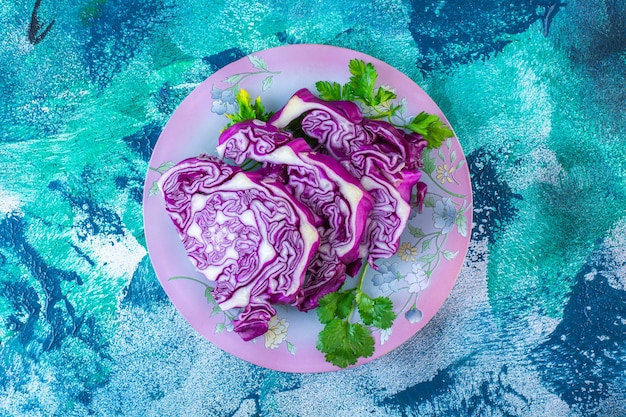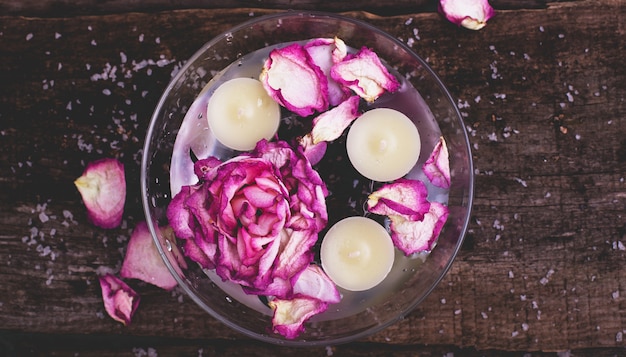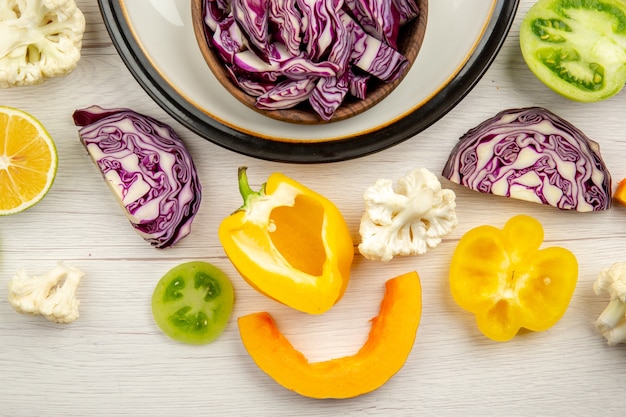Let's be honest, cabbage often gets a bad rap. It's often associated with those stodgy, overcooked, slightly smelly dinners of our childhood. But trust me, that's just not the case! When prepared properly, boiled cabbage can be a simple, healthy, and surprisingly delicious side dish. I'm talking perfectly tender leaves, infused with a subtle sweetness and a delicate crunch. It's a revelation, I tell you! It's the kind of side dish that can transform a humble meal into something truly special.
My love affair with boiled cabbage began with my grandma. She used to make the most amazing pot of cabbage, perfectly cooked, with just the right amount of salt and pepper. It was always a highlight of our family meals, and I've been trying to recreate her magic ever since. It’s taken a bit of trial and error, but I've finally cracked the code. And guess what? It's so simple, even a beginner cook can master it.
(Part 1) The Right Cabbage

The first step to achieving cabbage perfection is choosing the right one. You want a head that's firm, heavy for its size, and has bright green leaves. Avoid any with wilted or yellowed leaves, as these are signs of age and potentially a less-than-ideal texture.
The Cabbage Types
While any type of cabbage can be boiled, some are better suited for this method than others. Green cabbage, with its tightly packed leaves, is my personal favourite. It holds up well to boiling and doesn't get too mushy. Its mild, slightly sweet flavour is versatile and complements a wide range of dishes. Savoy cabbage, with its ruffled leaves, adds a lovely textural contrast to the dish, creating a delightful interplay of textures and flavours. Red cabbage, on the other hand, has a slightly stronger flavour and tends to bleed into the water, which might not be ideal for everyone. Its vibrant colour makes it a stunning addition to salads or as a garnish, but for boiling, it's best to use a lighter variety. If you're looking for a milder flavour, you can also try Napa cabbage, which is often used in Asian cooking. Its delicate flavour and tender texture make it a good choice for stir-fries and other Asian-inspired dishes, but it also works well in boiled dishes.
(Part 2) Preparing the Cabbage

Once you’ve got your perfect cabbage, it’s time to prepare it for boiling. Here’s the simple process:
1. Wash and Core
Wash the cabbage thoroughly under cold running water. Use a sharp knife to cut off the tough outer leaves and the core. The core is that hard, white part in the centre of the cabbage. You can discard these leaves or use them for other purposes, like making cabbage soup or stock.
2. Cut the Cabbage
Now, you have two options for cutting the cabbage:
- Cut into Wedges: This is my preferred method, especially for larger heads of cabbage. Simply cut the cabbage in half, then cut each half into wedges. This ensures even cooking and creates a lovely presentation. The wedges retain a good amount of their shape, making them visually appealing and easy to eat.
- Shred: If you want smaller pieces, you can shred the cabbage into thin strips. This is a good option if you're serving it with other dishes or want a faster cooking time. You can shred it by hand or use a mandoline or food processor for faster results. Shredded cabbage cooks more quickly and integrates well into dishes like coleslaw or stir-fries.
(Part 3) The Boiling Process

Now, it's time to start boiling. Here's how to do it:
1. Boil Water
Fill a large pot with water. You want enough water to cover the cabbage completely, with a few inches to spare. Bring the water to a rolling boil over high heat. The trick is to get that water bubbling and furiously steaming!
2. Add Salt
Once the water is boiling, add a generous amount of salt. This will season the cabbage and help to draw out its natural sweetness. I usually use about 1 teaspoon of salt for every 4 cups of water. You can adjust this to your taste preference. The salt not only adds flavour but also helps to preserve the cabbage's vibrant green colour during cooking.
3. Add the Cabbage
Carefully drop the prepared cabbage into the boiling water. Give it a quick stir to ensure all the pieces are submerged. It's important not to overcrowd the pot. If you're using a large head of cabbage, you might need to do this in batches.
4. Reduce Heat
Immediately reduce the heat to medium-low, ensuring the water is gently simmering. You want to maintain a gentle simmer throughout the cooking process. This slow, gentle simmering helps to prevent the cabbage from becoming overcooked and mushy.
(Part 4) Cooking Time
The cooking time for cabbage depends on the size and type of cabbage you're using, as well as your preferred texture. Here’s a general guide for boiling cabbage:
Wedges
For wedges of green cabbage, I usually boil for about 15-20 minutes. If you prefer a softer texture, you can boil for a few minutes longer. The key is to test the cabbage with a fork, if it goes through easily it’s ready! You can also check the colour of the cabbage; it should be a vibrant green colour, not a dull or faded green.
Shredded
Shredded cabbage cooks much faster. It's usually ready within 5-10 minutes. Again, you want to check the cabbage with a fork to ensure it’s cooked through. The cabbage should be tender but still retain some bite.
(Part 5) Draining and Serving
Once the cabbage is cooked to your liking, it’s time to drain it. Here’s how:
1. Drain the Cabbage
Carefully remove the cabbage from the pot using a slotted spoon or tongs. Drain it thoroughly in a colander.
2. Serve Immediately
Boiled cabbage is best served immediately. It can be served hot, warm, or even at room temperature. The freshness of the cabbage is what makes it so delicious, so it's best to enjoy it as soon as possible after cooking.
(Part 6) Flavoring Options
Boiled cabbage is a wonderfully versatile side dish. While a touch of salt and pepper can do wonders, you can also get creative and add additional flavours. Here are some ideas:
1. Butter and Herbs
The classic combination! Add a knob of butter and a sprinkle of fresh herbs like parsley, chives, or dill to the drained cabbage. It adds a touch of richness and freshness. The butter helps to enhance the flavour of the cabbage and the herbs add a bright, aromatic note.
2. Lemon Juice
A squeeze of lemon juice adds a bright, tangy flavour to the cabbage. This can be especially good if you're serving the cabbage alongside fish or chicken. The acidity of the lemon juice helps to cut through the richness of the meat and create a balanced flavour profile.
3. Vinegar
A splash of vinegar, like apple cider vinegar or white vinegar, can create a delicious tangy dressing. It’s a simple way to add a unique flavour profile. The vinegar can be added to the cabbage while it is still hot, allowing the flavours to meld together.
4. Garlic
A clove or two of minced garlic can infuse the cabbage with a wonderful aroma and flavour. You can add the garlic to the boiling water along with the cabbage or sauté it in a bit of butter or oil and then add it to the cooked cabbage.
5. Caraway Seeds
A sprinkle of caraway seeds adds a warm, earthy flavour to the cabbage. These seeds have a slightly bitter flavour that complements the sweetness of the cabbage. You can add the seeds to the boiling water or sauté them in butter before adding them to the cooked cabbage.
(Part 7) Storage and Leftovers
While it's best to serve boiled cabbage fresh, you can store leftovers in the fridge for up to 3 days.
1. Store in the Fridge
Place the leftover cabbage in an airtight container or resealable bag. Store in the fridge for up to 3 days.
2. Reheating
To reheat, you can microwave it for a few minutes or gently warm it up in a pan with a bit of butter or oil. While reheating, you can add a splash of water to help retain moisture.
(Part 8) Tips and Tricks
Here are some extra tips and tricks to help you achieve boiled cabbage perfection:
1. Don’t Overcook
Overcooked cabbage is mushy and loses its flavour. Keep a close eye on it and remove it from the pot as soon as it’s tender. Check the cabbage with a fork and it should be tender but still have some resistance.
2. Use Fresh Herbs
Fresh herbs really make a difference in the flavour of boiled cabbage. Use them sparingly to avoid overpowering the delicate flavour of the cabbage.
3. Be Creative
Don’t be afraid to experiment with different flavour combinations. You can add mustard, horseradish, or even a little bit of curry powder to your cabbage. Let your culinary creativity flow and try different flavour combinations to find your perfect match.
4. Add a Splash of Vinegar
Adding a splash of vinegar to the boiling water can help to brighten the flavour of the cabbage. Apple cider vinegar, white vinegar, or even a splash of balsamic vinegar can work wonders.
5. Consider a "Cabbage Bath"
After the cabbage is cooked, you can give it a quick "bath" in ice water to stop the cooking process and retain its vibrant green colour. This helps to prevent the cabbage from turning a dull, brownish colour.
(Part 9) Pairing Boiled Cabbage
Boiled cabbage is a fantastic side dish that pairs well with a variety of main courses.
1. Roasted Meats
It's a perfect complement to roasted meats like pork, chicken, and beef. The sweet and tangy cabbage cuts through the richness of the meat. It's a classic pairing that brings a balance of flavours to the meal.
2. Fish and Seafood
It can also be a great side dish for fish and seafood, especially lighter, delicate varieties. It’s a simple, healthy option that won't overpower the flavours of the fish. Boiled cabbage pairs well with grilled fish, baked fish, and even seafood stews.
3. vegetarian dishes
Boiled cabbage is a great option for vegetarians, too. It can be paired with vegetarian stews, soups, and casseroles. It adds a hearty texture and a slightly sweet flavour that complements a variety of vegetarian dishes.
4. Sausage
Boiled cabbage is a traditional accompaniment to sausage, especially german sausage like bratwurst or weisswurst. The cabbage adds a refreshing contrast to the richness of the sausage.
5. Potatoes
Boiled cabbage can also be paired with potatoes, whether boiled, mashed, or roasted. The combination of cabbage and potatoes is a classic side dish that is both comforting and satisfying.
(Part 10) FAQs
Here are some frequently asked questions about boiled cabbage:
- What is the best way to cut cabbage for boiling?
Cutting the cabbage into wedges is my preferred method. This ensures even cooking and creates a lovely presentation. The wedges retain their shape well, making them visually appealing and easy to eat. You can also shred it for a faster cooking time, especially if you're serving it with other dishes. Shredded cabbage cooks more quickly and integrates well into dishes like coleslaw or stir-fries.
- How long do I boil cabbage?
The cooking time depends on the size and type of cabbage, as well as your preferred texture. Wedges of green cabbage usually take 15-20 minutes. Shredded cabbage cooks much faster, typically within 5-10 minutes. Always check the cabbage with a fork to ensure it’s cooked through. The cabbage should be tender but still retain some bite.
- How do I know when cabbage is done?
You can tell when cabbage is done by its texture. It should be tender but not mushy. If you can easily pierce the cabbage with a fork, it’s ready. The cabbage should have a vibrant green colour and should not be discoloured or mushy.
- What can I do with leftover cabbage?
Leftover cabbage can be stored in the fridge for up to 3 days. You can reheat it in the microwave or gently warm it up in a pan. You can also use it in other dishes, like coleslaw or cabbage soup. It can also be added to stir-fries or used as a filling for wraps or sandwiches.
- What are some good flavor combinations for boiled cabbage?
There are many ways to flavor boiled cabbage. You can add butter and herbs, lemon juice, vinegar, garlic, or even a bit of spice. Experiment and find what you like best! A classic combination is butter and herbs, but you can also try adding a splash of lemon juice or vinegar for a tangy flavour.
- Why does my cabbage turn brown when I boil it?
Cabbage can turn brown when it is overcooked or if it is exposed to air for too long. To prevent browning, make sure to boil the cabbage until it is tender but still has some resistance. You can also add a splash of vinegar to the boiling water to help preserve the cabbage's vibrant green colour.
So there you have it, the secrets to making perfect boiled cabbage. It’s a simple, healthy, and surprisingly delicious side dish that can elevate your next meal. Give it a try and see for yourself! And who knows, you might just find yourself falling in love with this often-overlooked vegetable!
Everyone is watching

Prime Rib Roast Cooking Time Chart: Per Pound Guide
Cooking TipsPrime rib roast. Just the name conjures images of lavish dinners, crackling fires, and hearty laughter. It’s ...

How Long to Bake Potatoes in the Oven (Perfect Every Time)
Cooking TipsBaked potatoes are a staple in my kitchen. They're incredibly versatile, delicious, and surprisingly easy to m...

Perfect Rice Every Time: The Ultimate Guide to Cooking Rice
Cooking TipsAs a self-proclaimed foodie, I've always been a bit obsessed with rice. It's the foundation of countless cuisi...

The Ultimate Guide to Cooking Asparagus: Tips, Techniques, and Recipes
Cooking TipsAsparagus. The mere mention of this spring delicacy conjures up images of vibrant green spears, crisp and burs...

Ultimate Guide to Cooking the Perfect Thanksgiving Turkey
Cooking TipsThanksgiving. Just the word conjures up images of overflowing tables laden with delicious food, the scent of r...
